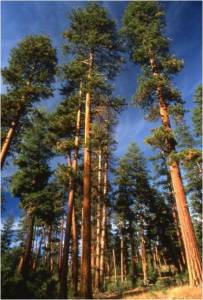Community Forestry
 Overview of the Forest Sector
Overview of the Forest Sector
For much of the 20th century Central Oregon’s forests provided the raw material for an extensive forest products industry. Primary and secondary wood products manufacturers helped shape our community by bringing in-migrants to the region, providing them with incomes and benefits, building infrastructure and transforming the forest.
Today, in addition to valuing the forest for the wood fiber it provides to industry, our community values the forests for the wildlife habitat, recreational assets, clean water, and aesthetic and spiritual value they provide. Forests thick with hazardous fuels can also threaten our communities with high severity wildfire. Forest management in the 21st century must address and reconcile multiple community values and interests. The forest products industry no longer dominates the local economy, but it still provides significant employment in the region and – in partnership with a range of other stakeholders – has an important role to play in restoring the ecological health for local forests.
Forest Collaboratives
For decades, competing visions of how to manage our federal forest lands have mired us in conflict and little work was done on the ground to help restore our local forests and protect them from high severity fire, insects, and disease. Collaboration is a new approach to engaging diverse interest groups in forest management. It is helping to build new agreement a shared vision for stewardship that will sustain our forests into the future. COIC provides staffing for three large-scale collaborative efforts in the region:
The Deschutes Collaborative Forest Project (DCFP)
The Ochoco Forest Restoration Collaborative (OFRC)
Central Oregon Partnership for Wildfire Risk Reduction
